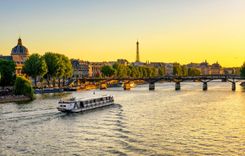Cultural etiquette to know before visiting France
France isn’t as buttoned-up as the stereotypes suggest, but there is a rhythm to how things are done – and getting it right makes a big difference. A bit of cultural awareness goes a long way, especially in cities like Paris, where manners matter more than you think. These France travel tips will help you blend in – or at least not stand out for the wrong reasons.
Dress: understated and polished
The French don’t do sloppy. You don’t need designer labels, but neat, neutral, and put-together is the baseline. Flip-flops, gym clothes, or loud tourist gear? Not a good look outside the beach. Even in casual settings, people make an effort – especially in cities.
When visiting churches or traditional towns, modesty still counts. Cover shoulders, skip super-short shorts, and leave beachwear for the coast.
Greetings and social norms: formal at first
A polite “Bonjour” goes a long way. Always greet shopkeepers, servers, and reception staff – ignoring them is seen as rude. Use “Madame” or “Monsieur” until invited to do otherwise.
Handshakes are standard among strangers; friends greet with a kiss on both cheeks – usually starting on the left. If you mess it up, smile and move on.
Public behavior: calm and considerate
France values quiet confidence. Loud voices, public outbursts, or being overly familiar in public won’t earn you points – especially in smaller towns. Queues are taken seriously. So is personal space.
Public affection is fine, but nothing too steamy. Keep party vibes private.
Eating customs: ritual, not routine
Meals are an event – sit down, slow down, and don’t rush. Don’t expect to eat dinner before 8 pm. Say “Bon appétit,” wait until everyone is served, and use utensils properly (yes, even for pizza sometimes).
Don’t split the bill unless the server offers – it’s not a given. And don’t ask for substitutions or over-customize your order – French menus are not choose-your-own-adventure.
If invited to someone’s home, bring wine, dessert, or flowers – but never chrysanthemums (they’re for funerals).
Religion and customs
France is secular, but historic churches and cathedrals still matter. Dress respectfully, speak softly, and check if photography is allowed. Big holidays like Bastille Day (14 July) or All Saints’ Day (1 November) may affect opening hours or transport.
Local festivals can be deeply rooted in tradition – join in if invited, but follow the lead.
Tipping and small gestures
Service is included in restaurant bills, but leaving a euro or two is appreciated. For excellent service, 5-10% is polite.
In cafés, round up. For taxis, round up or add a euro or two. Hotel staff and guides always appreciate small tips.
Always say “Merci” (thank you), “S’il vous plaît” (please), and “Excusez-moi” (excuse me). Good manners go a long way – especially in a country that still takes pride in them.















